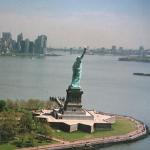DOUG JOHNSON: Welcome to American Mosaic in VOA Special English.
(MUSIC)
I’m Doug Johnson.
Today, music by Sahara Smith.
And we answer a question about the Statue of Liberty.
But first, a visit to the Robert Frost Farm in New Hampshire, where the harvest is poetry.
(MUSIC)
Robert Frost Farm
ROBERT FROST: (from “The Road Not Taken”)
I shall be telling this with a sigh
Somewhere ages and ages hence:
Two roads diverged in a wood, and I–
I took the one less traveled by,
And that has made all the difference.
DOUG JOHNSON: Robert Frost was one of America’s greatest poets, and most influential teachers and thinkers. He won four Pulitzer Prizes, a Congressional Gold Medal and served as the nation’s Poet Laureate.
Many of Frost’s best-loved poems were about the years he spent with his young family on a farm in Derry, New Hampshire. Faith Lapidus takes us there.
FAITH LAPIDUS: You could drive right by the Robert Frost Farm if you were not looking for it. It is a simple, white wooden farm house. It is not unlike other farmhouses of the same age in the area.
The grounds are still green and flowery at this end of the summer visit. Birds sing loudly; insects buzz. There is a cleared field but trees are what you mostly see. Some of them are the birches Frost wrote about. Here he reads part of the poem, “Birches.”
ROBERT FROST:
When I see birches bend to left and right
Across the lines of straighter darker trees,
I like to think some boy’s been swinging them.
But swinging doesn’t bend them down to stay
As ice-storms do. Often you must have seen them
Loaded with ice a sunny winter morning
After a rain. They click upon themselves
As the breeze rises, and turn many-colored
As the stir cracks and crazes their enamel.
Soon the sun’s warmth makes them shed crystal shells
Shattering and avalanching on the snow-crust–
Such heaps of broken glass to sweep away
You’d think the inner dome of heaven had fallen.
Robert Frost lived at the Derry farm from nineteen hundred to nineteen eleven. His wife Elinor had persuaded Frost’s grandfather to buy the farm for them. She had hoped a new start in farming would help her husband deal with the tragic loss of their four-year-old son to the disease cholera.
Randee Rae Martin is a guide at the Robert Frost Farm. She says Frost decided he would raise chickens. He also owned one cow. She said he enjoyed the attempt at farming but was not good at it. The farm was a good place for him to write and find sources for poems, however. The cow was one of them.
“The Cow in Apple Time” is a poem about how the cow decided she liked apples instead of grass. Eating apples caused an effect like people drinking alcohol. The poet says the cow stopped producing milk as a result. A young visitor to the farm reads the end of the poem:
YOUNG VISITOR:
She runs from tree to tree where lie and sweeten.
The windfalls spiked with stubble and worm-eaten.
She leaves them bitten when she has to fly.
She bellows on a knoll against the sky.
Her udder shrivels and the milk goes dry.
Bill Gleed is park manager of the Robert Frost Farm. He explains that “The Cow in Apple Time” is an example of Robert Frost’s poetic fooling. He says Frost’s cow did go dry, but not because of eating apples. He said Frost kept poet’s hours instead of farmer’s hours. He did not get up early to milk the cow. He did not milk her until the middle of the day. And that is really why her milk went dry.

Ed Bracken
The kitchen where Robert Frost wrote “Storm Fear” and “Tree at My Window
The tour of the farmhouse provides a sense of how the Frosts lived with no electricity or running water. Visitors can sit in the kitchen where Robert Frost wrote “Storm Fear” and “Tree at My Window.”
The house was carefully refurnished with the help of Frost’s eldest daughter, Lesley Frost Ballantine. She worked to reproduce her childhood home as closely as possible. Many of the books and other objects in the living room belonged to the family, including her father’s favorite reading chair. Frost had one in every house he owned.
Robert Frost lived most of his life in Massachusetts. But he said several times the place where he was happiest was the farm in Derry. He wrote in a letter to a friend: “The core of all my writing was probably the five free years I had on the farm…”
Lady Liberty
DOUGH JOHNSON: Our listener question this week comes from Thailand. Nanthachai Tubtimsuwan wants to know about the history of the Statue of Liberty, one of the most famous statues in America.
To many people the statue is known as Lady Liberty. She stands on a small island in New York harbor, near the great city. In her right hand, she holds a torch with a golden flame high above her head. Her left arm holds a tablet with the date July fourth, seventeen seventy-six.

nps.gov
The Statue of Liberty in New York Harbor
That is the day the United States declared its independence. On her head is a crown of seven points that represent the seven continents and the seven seas. Around her feet is a broken chain that represents oppression.
The Statue of Liberty was a gift to the United States from the people of France. Its official name was “Liberty Enlightening the World.” Frederic Auguste Bartholdi built the statue in several parts. These were shipped to New York and then put together on a base, or pedestal. The statue was dedicated in a ceremony on October twenty-eighth, eighteen eighty-six.
The statue itself stands about forty-six meters tall. The distance from the ground to the top of the golden torch is about ninety-three meters. The statue can be seen from far away. For the many millions of immigrants who came to America on ships, the Statue of Liberty was the first thing they saw.
In eighteen eighty-three, American poet Emma Lazarus wrote a poem as if Lady Liberty were speaking. In part it says: “Give me your tired, your poor, your huddled masses yearning to breathe free … I lift my lamp beside the golden door.”
Today, more than three million people visit the Statue of Liberty each year. Most come by a ferryboat from New York. Some visitors go inside the statue and climb as high as the crown to look down on the harbor. Others stay on the ground, take photographs, read Emma Lazarus’ poem and enjoy being close to Lady Liberty.
Sahara Smith
DOUG JOHNSON: Sahara Smith writes and sings poetic songs influenced by country and folk music. The twenty-one year old musician from Texas started writing songs at the age of nine. She recently released her first album “Myth of the Heart”. Mario Ritter tells us more.
(MUSIC)
MARIO RITTER: That was “Train Man.” Like many songs on the album, this one expresses a deep sense of longing and heartbreak that is surprising for such a young performer.

myspace.com
Sahara Smith
Sahara Smith grew up in Wimberly, Texas. Her father showed her how to play a guitar at the age of eight, and she soon began writing her own songs. At the age of twelve, she began performing in local restaurants. She gained wider attention three years later when she performed during a contest for young musicians on the National Public Radio program “A Prairie Home Companion.”
Here is Sahara Smith performing the dreamy song “Mermaid.”
(MUSIC)
Sahara Smith says her songs are influenced by singers including Tom Waits and Leonard Cohen. But she says many of her songs come from her own feelings of sadness and heartache. She says she can release these emotions by making music.
We leave you with “The Real Thing.” It tells about driving all night and the possibility of love.
(MUSIC)
DOUG JOHNSON: I’m Doug Johnson. Our program was written by Jim Tedder, Dana Demange and Caty Weaver, who also was the producer. Join us again next week for AMERICAN MOSAIC, VOA’s radio magazine in Special English.